A Missionary Church: AD 33-1843
Catholics draw their missionary inspiration from Jesus’ instruction in Matthew 28:19: “Go, therefore and make disciples of all nations…” These words have inspired countless men and women to abandon the comfort of their homes and families and to travel the globe to proclaim the Good News of Christ’s Resurrection.
Christianity spread from Palestine both east and west. Using the roads of the Roman Empire (and the safety and security that the Roman legions and navy provided on land and sea), early disciples of Jesus traveled to many of the great cities creating local churches. Rome, the capital of the empire and the site of the martyrdom of SS. Peter and Paul became an important center point. These churches evolved in structure and organization to create the Christian Church. In the west, it eventually became unified under the leadership of the Bishop of Rome, later referred to as the pope.
Theological and organizational evolution led to the formation of religious orders of men and women who proclaimed the gospel in new lands and cultures. Christianity demonstrated a talent for adapting to local conditions and languages, often building on the religious sensibilities of the people they sought to evangelize. Using Roman administrative tools, the world was divided up into territorial units known as dioceses, presided over by bishops.
The era of discovery and encounter (1492-1600) opened North and South America and the Caribbean to Christian evangelical efforts. Priests of different religious orders, Franciscans, Dominicans, and Jesuits, came to North America to convert native peoples to Christianity. These encounters were often mutually beneficial, with missionaries learning the languages of native peoples, their folkways, and their social structure. Many native people accepted whole or in part some of the lessons the missionaries came to bring. Others rejected Christianity. Many native peoples died of diseases brought over by European soldiers and colonists. France, England, and Spain were the main claimants to North American territories. Extracting wealth from the North American frontier (furs and other peltry) became a primary economic motivator for French penetration of the North American interior.
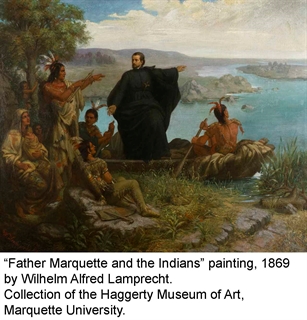 New France had control over the area that later became Wisconsin. Other priests worked here, but the French Jesuits took the lead. Father Rene Menard, S.J. is thought to have been the first Catholic cleric in Wisconsin (1661). Other Jesuit missionaries included Claude Allouez, Claude Dablon, and perhaps the most famous, Jacques Marquette (1637-1675). These men plied the inland waters of Wisconsin, launching out from mission stations on the upper peninsula of Michigan to form mission stations in Green Bay and Prairie Du Chien. Encountering the native peoples produced some conversions, although it is difficult to ascertain how many remained Catholic.
New France had control over the area that later became Wisconsin. Other priests worked here, but the French Jesuits took the lead. Father Rene Menard, S.J. is thought to have been the first Catholic cleric in Wisconsin (1661). Other Jesuit missionaries included Claude Allouez, Claude Dablon, and perhaps the most famous, Jacques Marquette (1637-1675). These men plied the inland waters of Wisconsin, launching out from mission stations on the upper peninsula of Michigan to form mission stations in Green Bay and Prairie Du Chien. Encountering the native peoples produced some conversions, although it is difficult to ascertain how many remained Catholic.
Internal church politics temporarily ended the Jesuit missionary enterprise (the Order was suppressed from 1765-1815). Among Wisconsin’s small population were only a handful of white settlers and native peoples who sustained their Catholic faith by home devotions. From 1781-1820, apart from the occasional itinerant, there were no priests in Wisconsin to offer Mass or hear confessions.
The Catholic Church came back to life in Wisconsin after the American Revolution, when the area passed into the hands of the new United States. Wisconsin was part of the territory known as the Old Northwest. The U.S. government regulated and integrated undeveloped lands into the new nation and allowed the surveying and sale of Western lands. In the 1830s, settlers begin to make their way to Wisconsin. By 1848, it became a state of the Union.
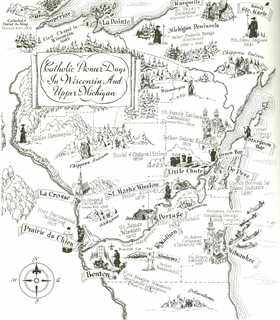 Catholic Church organization took place over this time. In 1789, Roman authorities formed a new diocese at Baltimore and appointed Maryland resident (and former Jesuit) John Carroll as the first bishop. Carroll’s jurisdiction at this time extended over the entire United States (which extended only to the Mississippi River.) Subsequent divisions created new dioceses over the land as the numbers of Catholics increased, many of them immigrants from Northern and Western Europe.
Catholic Church organization took place over this time. In 1789, Roman authorities formed a new diocese at Baltimore and appointed Maryland resident (and former Jesuit) John Carroll as the first bishop. Carroll’s jurisdiction at this time extended over the entire United States (which extended only to the Mississippi River.) Subsequent divisions created new dioceses over the land as the numbers of Catholics increased, many of them immigrants from Northern and Western Europe.
The extinguishing of Native American claims in the 1830s and the subsequent federal land survey set off a mini-land rush to Wisconsin. A second wave of missionary activity ensued in Wisconsin, spearheaded by Dominican Samuel Charles Mazzuchelli (1806-1864), Theodore van den Broeck (1783-1851), and Frederick Irenaeus Baraga (1797-1868). Priests from the Diocese of Detroit crossed Lake Michigan to help tend to scattered Catholic flocks in lake port towns like Milwaukee, Racine, and Southport (Kenosha) and Catholics who lived in the interior of the state. Green Bay and Prairie du Chien reassumed their primacy as Catholic centers, but Milwaukee, which would become the most populous city in Wisconsin, began its Catholic presence in 1833 when local trader Solomon Juneau welcomed Father Florimond Bonduel to celebrate Mass in his home. Immigrants from the east and abroad soon poured into the growing cities formed along the lakefront. By 1846, Milwaukee was chartered as a city.
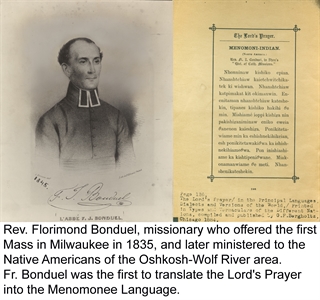
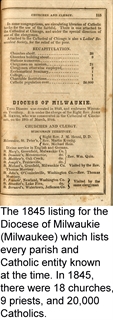 The growing number of Catholics in the Wisconsin Territory reached a critical mass by 1843. In May 1843, the bishops of the United States met in Baltimore for a Provincial Council. (The U.S. had only one ecclesiastical province at the time.) During these deliberations they heard reports about Catholic growth in the “west”—in Arkansas, Illinois, and Wisconsin. They recommended to the Congregation of the Propagation of the Faith in Rome that new dioceses be created in these states—chosing the most populous and financially promising city as the diocesan center. The choice in Wisconsin was for Milwaukee—although the older centers of Catholic life, Green Bay and Prairie du Chien may have been considered.
The growing number of Catholics in the Wisconsin Territory reached a critical mass by 1843. In May 1843, the bishops of the United States met in Baltimore for a Provincial Council. (The U.S. had only one ecclesiastical province at the time.) During these deliberations they heard reports about Catholic growth in the “west”—in Arkansas, Illinois, and Wisconsin. They recommended to the Congregation of the Propagation of the Faith in Rome that new dioceses be created in these states—chosing the most populous and financially promising city as the diocesan center. The choice in Wisconsin was for Milwaukee—although the older centers of Catholic life, Green Bay and Prairie du Chien may have been considered.
 In anticipation of the May meetings, Father Martin Kundig helped advance Milwaukee as the most logical site: its’ lake port was booming and it was attracting “respectable” and well-heeled settlers. It also had an active church and school in place. Kundig held a St. Patrick’s Day outdoor Mass that attracted 3,000 people. After the Mass, a colorful public demonstration took place. Lead by Kundig “on a spirted horse” Catholics marched (and presumably sang) in the streets of the city. Banners flew and Temperance Society members (in colorful sashes and badges) marched--awakening Milwaukee to the Catholic presence in their midst. Kundig proved himself to be as astute a city booster as any land speculator or land salesman.
In anticipation of the May meetings, Father Martin Kundig helped advance Milwaukee as the most logical site: its’ lake port was booming and it was attracting “respectable” and well-heeled settlers. It also had an active church and school in place. Kundig held a St. Patrick’s Day outdoor Mass that attracted 3,000 people. After the Mass, a colorful public demonstration took place. Lead by Kundig “on a spirted horse” Catholics marched (and presumably sang) in the streets of the city. Banners flew and Temperance Society members (in colorful sashes and badges) marched--awakening Milwaukee to the Catholic presence in their midst. Kundig proved himself to be as astute a city booster as any land speculator or land salesman.
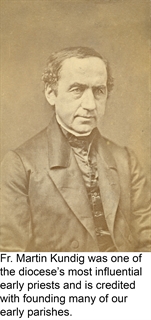 The Fathers of Baltimore likely had made up their mind about Milwaukee—but the boosterism of Father Kundig “sealed the deal.” On November 28, 1843, Pope Gregory XVI (a former prefect of Propaganda) issued the decree In Suprema Militantis, officially erecting the dioceses of Milwaukee, Chicago, Little Rock, Ark. and Hartford, Conn. The state had 9,000 Catholics and about 14 resident priests. John Martin Henni, a German-speaking Swiss-born priest from Cincinnati was appointed bishop and consecrated in March 1844. On May 5, 1844, he and a close friend, Father Michael Heiss arrived in Milwaukee. He would remain as bishop until his death in September 1881.
The Fathers of Baltimore likely had made up their mind about Milwaukee—but the boosterism of Father Kundig “sealed the deal.” On November 28, 1843, Pope Gregory XVI (a former prefect of Propaganda) issued the decree In Suprema Militantis, officially erecting the dioceses of Milwaukee, Chicago, Little Rock, Ark. and Hartford, Conn. The state had 9,000 Catholics and about 14 resident priests. John Martin Henni, a German-speaking Swiss-born priest from Cincinnati was appointed bishop and consecrated in March 1844. On May 5, 1844, he and a close friend, Father Michael Heiss arrived in Milwaukee. He would remain as bishop until his death in September 1881.
By Rev. Steven M. Avella
Photographs and documents courtesy of the Archdiocese of Milwaukee Archives, unless otherwise noted. Photographs and documents cannot be reproduced without prior written authorization. For permission to reproduce contact the archdiocesan archives.